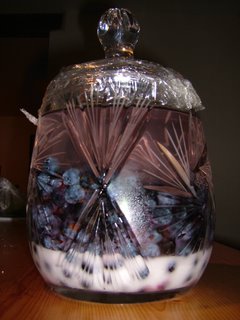Last year’s sloe gin has been steeping for ten months now – it’s time to decant. I found these pretty bottles at Lakeland (where they’re marketed especially for sloe gin), and filled four of them from last year’s Rumtopf.
I’ll be able to start collecting sloes, hopefully, some time next month. A quick recap – pick sloes after the first frost, prick them all over with a needle and for every pound of sloes you collect, pour over 8 oz of caster sugar and 1 ¾ pints of gin, then seal. You can leave the gin for as little as two months to steep, agitating the container occasionally, but the longer you leave it, the smoother the results will be.
I’ve had a few emails asking what a sloe bush looks like and where to find one, so I went down to the woods today (no big surprises) and took some pictures. The sloe is the fruit of the blackthorn bush, and you’ll often find them making up part of a hedgerow, or growing near the edge of a field. If you don’t live in the countryside, don’t despair – blackthorn can be found in scrubby land in towns, and is often planted in parks. Most of England’s public footpaths will have at least one sloe bush on its route, and a very pleasant afternoon can be spent foraging the hedgerows for a carrier-bag full.
The blackthorn bush grows to between 3 and 13 feet tall. If you have sharp eyes, you can identify the bush in the spring by its froth of white flowers and remember where it is for later in the year. Although the fruits here look purple and delicious, they’re not ready yet (September 1) – you really need to pick them after a frost, which gives them time to ripen, softens their astringency and makes them easier to prick. If, as happened last year, the frosts just aren’t happening, pick in November and put them in the freezer.
The sloes are nearly spherical and grow close to the branch. A raw sloe is a particularly disgusting beast – it’s sharp and astringent. It will make your tongue shrivel and your teeth squeak. These purple fruits are not sloes (compare with the picture above) – they’re wild plums, which ripen earlier, have longer stems, are soft to the touch and are sweetly delicious. If in doubt, have a nibble. Both fruits will have stones. If it’s delicious, it’s a plum. If it’s like sucking a fruity deodorant stick, it’s a sloe. The gin takes on all the fruit’s best characteristics, and none of the astringency.
Sloe gin is deliciously versatile. Try pepping up unremarkable Cava with a splash, drink it neat, use it in a martini or add some to mulled wine. I’ll be making another batch next month…until then, cheers!



